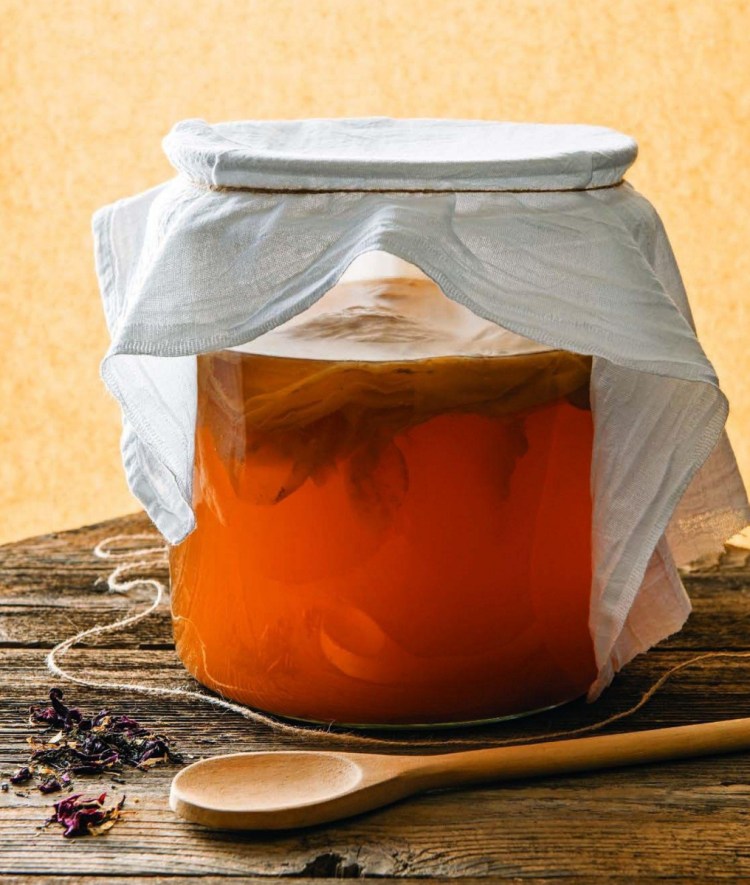“Kombucha, Kefir and Beyond: A Fun and Flavorful Guide to Fermenting Your Own Probiotic Beverages at Home.” By Alex Lewin and Raquel Guajardo. Fair Winds Press. $24.99.
In this era of unrelenting, super-food hype, kombucha is having its moment. Sales are skyrocketing. International beverage conglomerates like Pepsi and MillerCoors are snapping up producers to get in on the action, and a drink that was once bought for the most part in bougie health-food stores is now sold by the case at Walmart.

Kombucha – a lightly carbonated, fermented drink produced by marinating a firm, fleshy disc of yeast and bacteria (called a SCOBY, an acronym for Symbiotic Colony Of Yeast and Bacteria) in sweetened green or black tea – has been around for thousands of years, and although its origins have been lost to the mists of time, the smart money says it came out of China. Through the millennia, it acquired a reputation as a mystical elixir of good health, a “living” food that supposedly can do it all, from improving your digestion to perhaps even curing cancer, because it’s packed with probiotic goodness. And while the science doesn’t even come close to supporting those claims, kombucha’s popularity continues to soar, probably because it also happens to taste good and is naturally low in calories.
Unfortunately, kombucha is also pricey – a 16-ounce bottle runs around $4 – which means a kombucha habit can become expensive.
With a little effort, though, kombucha can be made by the gallon for pennies. So, when “Kombucha, Kefir and Beyond,” by Alex Lewin and Raquel Guajardo, came into my hands, I dug right into it.
Lewin and Guajardo come down squarely in the health camp, placing kombucha in the context of the broader, fermented-foods movement. In the wonderful, clear voice of the true believer, Lewin and Guajardo lay out in concise and easily accessible language exactly how to make kombucha, as well as pretty much any other fermented food you might have heard of – and a few you probably haven’t. There are recipes for, for example, Beet Kvass, a Slavic drink; Kimchi Soda; and Tejuino, a pre-Hispanic fermented corn drink that is still popular in Mexico.
No matter what the recipe, though, Lewin and Guajardo’s step-by-step instructions and precise measurements guide you through every phase of the process, and their expertise is on display without ever coming across as condescending or indulgent, evoking instead a sense of confidence in yourself and your efforts, even if you’re trying something that’s completely unfamiliar.
After an initial false start, owing more to my inadequate supplies than anything else, I followed the authors’ recipe for kombucha precisely. Two weeks later, the finished drink was ready. I cracked open a bottle and heard the comforting and familiar pop that signaled the presence of carbonation. It poured wonderfully, with everything one would want in a glass of kombucha fully present and accounted for. And it tasted great – even better than I’d hoped.
So while I’m still not sold on Lewin and Guajardo’s health claims, I certainly am a believer in that kombucha. If the other recipes in their book are anywhere near as good, this one’s a keeper.
Frank Gallagher is a writer in Portland. He blogs about weight loss, food and exercise at BariatricBoy.com.
KOMBUCHA
Recipe from “Kombucha, Kefir and Beyond” By Alex Lewin and Rachel Guajardo. This recipe calls for a SCOBY, which you can easily buy online. Or you can try growing one, using liquid from a store-bought bottle of kombucha; if you want to grow your own, use ‘booch from a local producer, because mass marketers often process their brew in a way that makes it hard to grow your own. Lastly, you can get a SCOBY from a friend who brews. Once you brew yourself, you’ll start accumulating them because they multiply; I got mine from a co-worker, and my first batch yielded two babies. (If you want one, I’m happy to pass one on.) The recipe also asks for “mature kombucha liquid,” which is the liquid your SCOBY comes in/is stored in, or a bit of kombucha left over from a finished batch. It’s chock-full of the bacteria and yeast from the SCOBY and facilitates the fermentation. Together, the SCOBY and the liquid are analogous to sourdough starter.
Yields 1 quart
1 quart filtered water
1 tablespoon (5g) loose tea or 2 teabags
1/4 cup (50g) sugar
1/4 cup mature kombucha liquid
1 healthy kombucha SCOBY
Boil 1 pint of the filtered water in a small pot over high heat. Remove from heat, add the tea and let steep for at least five minutes
Remove the tea leaves or bags. Add the sugar and stir with a wooden spoon until dissolved. Add the remaining pint of room-temperature water.
Once the sweetened tea has cooled to body temperature or below, transfer to a large glass jar with a wide mouth, leaving at least 3 inches of space on top. Add the kombucha liquid and place the SCOBY on top of the liquid (if it sinks, that’s OK). Cover the jar with a clean cloth, kitchen towel, paper towel or coffee filter and secure with a rubber band. Write the brewing date on a piece of masking tape and stick it to the outside of the jar.
Let the jar sit at room temperature to brew, between 75 degrees and 85 degrees, if practical. How long your kombucha needs to brew depends on the ambient temperature. It can take five days in warm weather or two to four weeks when it’s cold out.
Once the kombucha has reached the desired flavor, put the SCOBY aside with a bit of the liquid. Pour the finished kombucha through a strainer and bottle it in glass bottles. Cap it, optionally leave it out a day or two if you want effervescence, and refrigerate it.
Send questions/comments to the editors.


